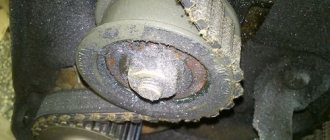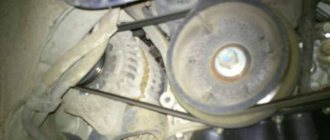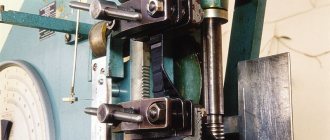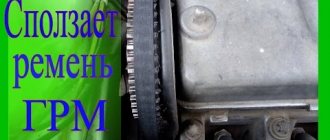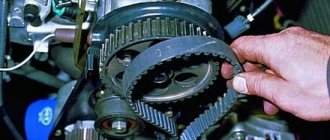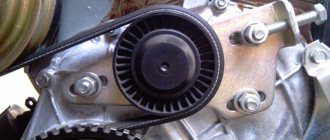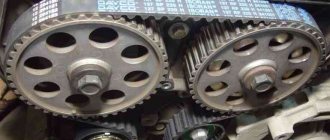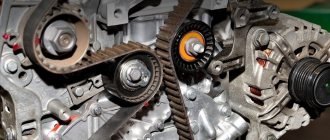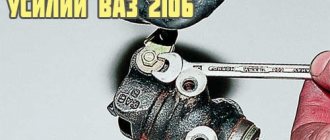Why do LADA owners care about the frequency of replacing the timing belt (gas distribution mechanism) on their cars? Mainly due to the consequences of a broken belt, in some cases the valve bends, which ends in expensive repairs. Let's figure out at what mileage the manufacturer recommends changing the timing belt and rollers, as well as what its actual service life is.
When to change the timing belt on a Lada Priora
New timing belt from Gates
Each car has a specific procedure for replacing certain spare parts.
AvtoVAZ has installed 105 thousand km to check the condition of the timing belt.
However, there are many factors that can lead to premature wear of drive parts. And this threatens, if not the capital of the entire engine, then serious repair costs. And that's why.
Why a timing belt may require replacement ahead of schedule
The owner replaced this belt ahead of schedule, although there are practically no signs of wear on it. So calmer!
Even if the belt is slightly damaged, and this can be not only a break, but also stretching, cutting off part of the teeth, contact of the valves with the piston heads is inevitable.
The result of contact can be the most unpredictable - from bending valves to destroying crankshafts or camshafts . Some engine models are free from this danger, since if the rotation angles of the crankshaft and both camshafts are mismatched, emergency niches for the valves are provided in the piston bottom.
The timing belt can be changed “to the heap” if play in the pump is noticed
Priora, unfortunately, cannot boast of this. That is why experts on Priorov engines strongly recommend checking the condition and, if necessary, replacing the timing belt after 40-50 thousand mileage .
Alternative manufacturers
Not all vehicle owners can choose the right spare part for their car. This is due to the wide variety of products, including timing belts. The main supplier of rubber products for VAZ cars is the RTI plant in Balakovo. In addition to this, sellers can offer buyers Bosch products, which have high quality workmanship and reliability. Also on display you can see products from the companies Daiko, Kontitek, Lynx. Their cost ranges from 700 to 1500 rubles.
Checking the condition of the belt
Checking the timing mechanism
Any checks and adjustments of the drive belt are carried out only on a cold engine. Its maximum temperature should be no higher than 35 degrees.
If the car has an air conditioner, you should remove its drive belt, and only after that handle the timing belt. To remove the air conditioner belt, you need to unscrew the engine mount, and after removing the belt, install the motor on the mount, lightly tightening the screws that secure it.
Checking the timing belt is performed in the following order:
- Find and unscrew the five screws securing the plastic protective cover.
- Remove the cover from the engine.
- Jack up the front wheel on the right.
- We set the gearbox to fifth gear.
- Turn the wheel clockwise.
- The inner surface of the belt should not have cracks, abrasions, folds, or delamination of the rubber material.
- The outer surface should be free of marks, cracks, signs of heavy wear and protruding cord.
- If stains of operating materials (oil, coolant) are found on the belt, it must be replaced, but only after the causes of the leak have been eliminated.
How to check and adjust belt tension on a Priora
Timing belt in action
After inspecting the condition of the timing drive, be sure to check the belt tension and the condition of the tension and support rollers. This should be done in the following sequence:
- We turn the crankshaft by the hanging wheel until the marks on the toothed pulleys of both camshafts align with the bosses on the rear drive casing.
- Pay attention to the tension roller: the cutout in its cage must clearly coincide with the boss of the sleeve inside the roller.
- If the belt is tensioned satisfactorily, the boss will coincide with the cutout, otherwise it is necessary to loosen the roller mounting bolt with a 15mm wrench.
- To adjust the belt tension, turn the roller itself - counterclockwise to tighten, clockwise to loosen.
- This can be done either with a special wrench, or a bicycle wrench of a suitable size with a grip, or pliers for removing the locking rings.
- The roller is rotated until the cutout and boss coincide, after which the roller mounting bolt is tightened with a force of about 40 Nm using a 15 wrench.
When adjusting, it is important not to overtighten the belt or loosen it, since in the first case it will quickly wear out and lead to failure of the pump bearing, and in the second case, teeth may slip and the valve timing may be disrupted.
Timing belt with signs of wear
As a result, the valves can strike the piston crowns, causing serious and costly failure.
Replacing the timing belt on a Lada Priora - when to change it and should you focus on mileage?
Replacing the timing belt is carried out on DOHC engines, which are installed on Prioras, as a rule, performed after 60 thousand km. mileage Despite the fact that the manufacturer recommends changing the belt closer to 200 thousand.
There are those who don’t wait and change the belt every 40-50 thousand, but where is the truth and when should you actually replace it? Let's figure it out.
DOHC engines on Priors have four valves per cylinder (two for intake, two for intake). The valves are opened by the action of pushrods, which allows for an additional advantage when it comes to power.
Synchronization of the intake and exhaust processes is realized using a belt drive. The belt itself is a toothed, dense ring consisting of several layers of rubber and nylon. The specification and compatibility of the belt is indicated on its sidewall, in this case the width is 22 mm, the number of teeth is 137. When buying a timing belt, you should be attentive to the quality of the product; it should not have defects such as scuffing, roughness, cracks and irregularities.
The timing belt on a Priora combines many components, bending around drive rollers and pulleys. So this belt is related to the coolant pump pulley, the camshaft pulleys that lift the valves, has one guide roller, and the degree of tension is regulated by a special tension roller. To install the belt, you must follow certain rules and take into account special marks located on the belt, crankshaft pulley, oil pump, and camshafts. From the Priora factory, they receive sets of timing belts and rollers manufactured by Gates; there seem to be no questions about the belts, but the plastic rollers are considered the “Achilles heel” of these sets. Those who have had bitter experience of using such belts and rollers strongly recommend replacing them early and checking their condition regularly.
How to check tension
At the end of the work, it is necessary to adjust the tension of the timing belt drive on the Priora. The adjustment is made as follows:
- Using a special wrench, you need to turn the tensioner pulley counterclockwise.
Tensioner adjustment key
You can check the tension by applying force to a rubber product weighing 10 kg. The deviation value should not exceed 5-7 mm.
When tightening the pulley and roller bolts, it is recommended to use a torque wrench. The tightening torque for each element is equal to the following values:
- for the tension roller – 35-41 Nm;
- thrust roller – 105-110 Nm;
- pump mounting bolts – 15-20 Nm.
After adjustment, you can put the protective cover back in place. Finally, the generator belt tensioner roller is installed, as well as the belt itself. It is also recommended to replace these elements with new ones. Finally, do not forget to fill the coolant before starting the engine.
Upon completion of the work done, you can start the engine and check its operation. If the marks are correctly set, the engine will start the first time the key is turned in the ignition switch. In this case, the engine should operate evenly and keep the speed in the region of 800-900 rpm. Listen to the timing belt drive. There should be no extraneous sounds or noises. The presence of a whistle or hum indicates that the tensioner is too tight and needs to be loosened.
Video: replacing the timing belt and rollers with a pump on a Priora VAZ 2172, 2170, 2172 (timing marks)
In conclusion, it should be noted that the process of replacing the timing belt on a Lada Priora car does not present any difficulties if all steps are performed one by one. Even an inexperienced driver can handle this procedure, so don’t be afraid when the time comes to replace the belt product.
Why is this so important?
I think it’s no secret to anyone what happens when the timing belt breaks, but perhaps there are those who are not in the know. In the event of a break, the synchronization of the operation of the cylinder-piston group and valves is disrupted. The pistons begin to move towards the valves, which are no longer controlled by the belt; as a result, the pistons “meet” the valves. After such a “meeting,” the pistons are destroyed, the valves are bent, and in general you end up with a major engine overhaul. Could this have been avoided? It is possible, of course, if the manufacturer of this engine thought about this at the design stage, completely eliminating such a phenomenon. By the way, there are quite a few “plug-in” engines in the world that, after a broken belt, do not need to be “overhauled”; you just need to get to a service station and replace the timing belt. In such engines, when the valve belt breaks, the valves do not meet the pistons.
The belt and rollers must be replaced immediately if, during inspection, you find:
- Roughness on the belt (on the teeth or sides);
- Mechanical damage;
- Engine malfunctions;
- Problems starting the engine;
- Extraneous sounds indicating friction of the belt against the casing, rollers or pulleys.
Separately, I would like to note the appearance of vibration and black exhaust; such symptoms, of course, can occur under other circumstances, but this option should also be considered.
Consider exclusively mileage in the question: “Is it time to change the timing belt or not?” - this is mistake. Firstly, even with low mileage, problems can arise with the belt or rollers. And secondly, there are many situations when you practically or completely do not move, while the motor is running, therefore, the belt wears out. For example, if the car is used mainly in the city, the mileage may be low, but the life of the belt itself will be at its limit, since in traffic jams the engine is running, but there is practically no movement.
There are other factors that can cause a belt to fail prematurely. For example, if oil, fuel, dirt or sand gets on it. Small particles of sand eat into the surface of the belt, destroying its surface; oil and other petroleum products soften it, reducing its strength and shortening its service life.
How to independently check the serviceability of the timing belt of a Priora car: Replacing the belt
Any auto mechanic will explain to the motorist that the timing belt must be changed regularly, otherwise its rupture during operation will damage the vehicle. All motorists will be able to replace the part if they carry out the preparatory stage correctly, remove interfering components for a while, and set the timing marks on the Priora.
Experts advise checking the condition of this component of the mechanism every 105 thousand kilometers traveled. It will be useful for motorists to learn how to disassemble the mechanism and check for damage to the belt.
What kind of belt is used?
On Priora cars with a 16-valve engine 21126, a toothed rubber belt with a number of teeth of 137 pcs is used. The width of the belt is 22 mm.
The article number of this element is 137-22 HNBR
This is what the timing belt used on Priors looks like
Also, many owners speak well of Gates belts.
What is a timing belt
This is the connecting part that ensures the synchronization of two vehicle components - the camshaft and crankshaft. However, the belt not only combines these two mechanisms, it is also connected to other parts, as a result of which a huge load is placed on it.
Due to this load, it is subject to wear and therefore must be replaced after the expiration date. If you neglect the recommendations specified in the Priora instructions regarding regular replacement, the belt will break and all the mechanisms associated with it will fail.
Untimely replacement will cost the car owner too much; it is advisable to constantly check the mechanism for damage and the first signs of wear.
Experienced auto mechanics advise not to believe the statements of official dealers that the timing belt on a Priora is replaced every hundred thousand kilometers traveled. Sometimes a rupture is possible after fifty thousand kilometers, but there are cases when the mechanism has traveled more than one hundred thousand kilometers. Therefore, schedule several checks, for example every 10,000 km, to ensure that the mechanics are functioning at the proper level.
It is made of high-quality and durable rubber, smooth on top and serrated on the inside. The teeth provide the strongest grip on the gears. If, due to a long period of use, parts of the teeth fall off, the car may not even start due to the fact that the automobile oil is untimely or incorrectly supplied to the cylinders located in the engine.
A simple rubber component plays an important role in the entire mechanism of the machine. Try not to forget about checking it, because a problem detected in time will save money spent on repairs.
Manufacturer's terms
The vehicle operating instructions recommend replacing the timing belt, tension roller, and pump after 200 thousand kilometers.
How long it actually takes to replace it depends on many factors. If the car drives most of the time on country highways without traffic jams, sudden acceleration and braking, the belt can last 200 thousand kilometers. Aggressive driving style, traffic jams, poor-quality consumables and maintenance reduce the actual service life of the timing belt.
Experienced owners of this model and repairmen recommend replacing it after 50–60 thousand kilometers. You need to check the condition of the timing mechanism parts every 10–15 thousand km.
Particular attention should be paid not only to the tension of the timing belt in the timing drive, but also to the condition of its teeth. It is their cutting that causes breakdowns followed by expensive repairs.
Pump and rollers
Normal operation of the timing mechanism drive cannot be ensured without a tension mechanism for the drive device. Since two camshafts are installed in the cylinder head, the length of the drive increases, which also required the installation of a support roller. Both of them are sealed bearings, with the difference that the tension roller rotates on the axis, thereby setting the required belt tension. The support roller only guides the belt as it rotates. Since the bearings are filled with lubricant during assembly, and they themselves are sealed, the manufacturer guarantees their reliable operation for the entire service period.
Many experienced repairmen and drivers check the presence of lubricant before installing the roller and add it themselves. The malfunction of these parts is indicated by noise when they rotate and the presence of play. And the coolant pump also rotates with the timing belt. It is the pump that most often causes teeth to be cut off. This occurs when the pump jams while the engine is running. If the owner of a Priora does not want to incur additional costs for repairing the power unit of his car, he needs to change the rollers and pump at the same time as the toothed belt.
Belt
This part in the timing mechanism drive transmits rotation from the crankshaft, two camshafts, and the coolant pump. The loads on the belt are large; high demands are placed on the quality of the material for its manufacture. It is quite difficult to break the body of the belt; most often its teeth are cut off.
Under ideal conditions, it runs for 150 thousand km. It is difficult to obtain such conditions on the roads of the CIS countries, especially in cities, so the service life of this part is reduced.
The optimal mileage when you need to replace the timing belt will be in the range from 50 to 60 thousand km.
There is confirmed data on earlier dates for performing such an operation, but in these cases, malfunctions in the valve drive mechanism, engine oil leaks, and the appearance of defects on the toothed belt were noted. The lubricant softens the composition of the belt material, which makes it easier to destroy, so engine oil leaks should not be allowed to occur, and if they occur, immediately repair the detected malfunction.
When to change: consequences of untimely change
It is recommended to replace the timing belt on a Priora after different periods of time. The manufacturer claims that it can withstand one hundred thousand mileage, but experience shows that a change may be needed much earlier.
The optimal period is every fifty thousand kilometers. Some argue that over such a short service life, rubber is simply not capable of failure. However, no one takes into account the conditions - roads, fuel quality, etc.
Also, during the operation of the mechanisms, it wears out, the rubber stretches, and therefore does not provide the correct tension of the timing belt, and slippage is possible. The teeth can wear off - because of this, traction with the gears is not ensured.
There is no exact time for a change that would suit all motorists. Some take good care of their vehicles, drive carefully, and use only high-quality fuel. Others use a more extreme type of driving, foreign liquids get on the rubber, etc.
In order not to lose your car during the repair period and not to spend a fortune on restoring the mechanics, write down or remember the date of the last timing belt change on the Priora. Next, regularly check the condition of the rubber; if worn, replace it with a new device.
Signs of possible failure
There are several characteristic signs that should alert the driver:
- When the engine is turned on, extraneous noise occurs. Sometimes drivers confuse a timing belt malfunction with a poorly functioning tension pulley.
- If the color of the exhaust gas has changed.
- The engine doesn't start well.
- An unusual vibration is felt.
Pay attention to these “symptoms”, even if the Priora’s mileage with a new timing belt has not yet reached 50 thousand km. It may fail earlier if foreign liquid gets onto the drive - oil, coolant, as well as dust or dirt.
It’s worse if it’s the coolant that gets onto the drive. Firstly, this means that the gasket that ensures the pump is sealed has failed, or there is a problem with the pump. Then the rubber is damaged and service life is reduced tenfold.
Even if the belt is new, but coolant or antifreeze gets on it, it will fail even after operating for 10 thousand miles. You will have to replace the Priora timing belt and figure out why foreign substances get on it.
How to check the serviceability of the belt yourself
If you suspect that it is time to replace the Priora timing belt, it would not hurt to check the serviceability of this rubber product. Visual diagnostics will allow you to check the serviceability and absence of scuffs on the Priora timing belt.
You should have a choice of one of the tools at hand, or two at once - a 5-point hex key, or a T-30 sprocket bit. If one doesn't work, try the second.
- Open and lift the hood.
- You will see the front panel covering the mechanism and timing belt.
- Take the key and unscrew the five bolts that hold the front panel, remove it.
- In front of you you will see a mechanism, including a tension roller.
- Place a jack on the passenger side and place the wheel in a suspended position. Engage fifth gear while it is working, look at the surface of the belt for damage, even small defects.
- If you notice cracks of any size, mechanical cuts, or threads sticking out, be sure to replace it by contacting a specialist or yourself.
- Check the pump. If any traces of coolant leakage from the pump are noticeable, then the rubber will also have to be changed, even if there is no mechanical damage.
- Check the tension roller. Auto mechanics advise changing it less often than tires. The average lifespan is approximately one hundred thousand kilometers. Change it every other time you change the belt.
- Measure the belt tension. To do this, press on the stretched rubber in the area between the gears of the two camshafts. You need to press with a force of about ten kilograms. Correct tension of the timing belt should not bend more than seven millimeters.
- Check that the rubber is not too loose. Make sure that the Priora timing marks match the original condition. The first, similar to a recess, is located on the outer race of the tension roller. The next one is located at the base of the roller. The maximum deviation is four millimeters; if the tension does not meet the standards, the product will have to be changed.
Found a discrepancy with the standards? Change the product. A belt set with rollers for the Priora 126 engine costs only five thousand rubles. This is a much smaller amount than the cost of a major repair if a component ruptures.
Changing the belt yourself
Replacing the timing belt of a Lada Priora with 16 valves is not the most difficult procedure. Buy a kit that includes tension rollers, stock up on tools, and you’re good to go.
Instructions
- Lift the hood, use a hex wrench to unscrew the five bolts on the cover, and remove it. Unscrew the two bolts from the lower timing cover.
- Disconnect the crankshaft sensor.
- On the passenger side, place a jack under the wheel, lift the car with it, and place the wheel in a suspended position. This will make it easier to align the marks of the mechanism and camshafts - they should be parallel, opposite each other. Combine them with fifth gear engaged, turning the wheel to the correct position. Turn off gear transmission.
- Find the flywheel and remove the rubber plug with a regular screwdriver. Under the muffler you will see a flywheel with a mark, it should be located opposite the mark on the left side.
- You need to get to the crankshaft pulley; to do this, remove the wheel or turn it to the right, you need to turn it all the way. Unscrew the five bolts that secure the mudguard.
- Ask a friend to engage fifth gear and press the brake, at this time, using ratchet No. 17, unscrew the bolt that secures the crankshaft pulley. Rotate in the opposite direction clockwise.
- Remove the thrust washer
- Unscrew the bolts securing the tension and thrust rollers. Use key 15. Remove the rollers, remove the belt.
- Now install new rollers, do not tighten the tensioner type, they will be used for adjustment. Reinstall the camshaft pulleys, then the crankshaft pulley.
- Put on a new belt - pull it onto the crankshaft, then around the pump, then onto the camshaft pulleys.
Replacing the alternator belt on a Priora with air conditioning VIDEO.
Types and models of alternator belts on a Priora with air conditioning
. Our automotive industry for drive.
Are there visible coolant or engine oil stains on the surface? If the contamination is not significant, they can be cleaned. If the liquid has penetrated into the material, cleaning will not bring any results; replacement is needed. If the component is well tensioned and no damage or stains are visible, then you should move on to checking the bearings. They may need to be changed.
Sometimes the generator consumable whistles due to the poor quality of the product. This is especially true for Chinese analogues, which are not of high quality. Such a belt whistles a lot already at the fifth thousand mileage, it is better to change it immediately. We recommend purchasing consumables designed for your model, in our case, for a Priora with a 16-valve engine.
The timing of replacing the timing belt on a Priora is often unpredictable and does not always depend on mileage!
The timing belt on a Priora is a mechanical connection that controls gas distribution in an internal combustion engine. It consists of camshafts, mechanical drives to them, transmission elements such as rods, pushers, rocker arms, valves that close and open the holes in the combustion chambers, adjusting elements, valve rotation systems, belts, etc. The camshaft drive allows it to rotate with angular velocity, which is defined as half the angular velocity of the crankshaft itself. Before deciding when to change the timing belt on a Priora, it is worth familiarizing yourself with how this mechanism works and what are the features of its operation.
Features of the Priora car
Motor of the new Lada
The engine on the Priora belongs to the class of so-called DOHC engines (Double overhead camshaft), which have two shafts, each for its own row of valves (two for exhaust, two for intake). The valves are driven by pushers, which gives an advantage in power delivery.
The timing belt on a Priora car is a rubber-mechanical product with teeth along the inner edge. Its rim indicates the type of engine for which the part is suitable, as well as markings indicating the number of teeth (137) and width (22 millimeters). When purchasing a timing belt, you should check its quality by pressing on a non-toothed surface. Obvious product defects include the appearance of longitudinal or transverse cracks, delamination, and excessive roughness on the teeth.
The timing belt goes through a tensioner pulley, a timing pulley on the crankshaft, a coolant pump pulley, a pulley (toothed) for the exhaust camshaft, a pulley for the intake camshaft, and an idler pulley. The system also has marks on the crankshaft pulley, oil pump, belt cover (rear), and on both camshafts.
In the factory configuration, the car is equipped with a Gates Kit timing belt with plastic rollers, which are not of good quality, so experienced “prior mechanics” prefer to change this part even before the recommended period expires.
What mileage should the car have to replace the belt?
Replacing the motor belt
It is necessary to change the belt, according to AvtoVAZ itself, when the Priora has a mileage of about 200,000 kilometers, however, it is believed that during short drives around the city this element wears out faster, therefore, according to surveys, some people change it already at 40,000 kilometers, while others only at 60 thousand mileage. This part needs to be inspected every 50 thousand kilometers. The first signs that the timing belt needs to be replaced are the following:
- extraneous noise when the engine is running;
- difficulties when starting a Priora car;
- the engine has very strong vibration (to the point of trembling throughout the entire body);
- exhaust fumes are blacker than usual.
A low mileage of a car cannot always guarantee that a situation has not arisen where the belt needs to be changed. Very often, the belt drive wears out prematurely due to the fact that oil penetrates through the seals; cracks in the casing allow dirt to penetrate. These components quickly destroy the rubber of the belt, because it peels off from the cord, and dust mixed with oil gives a destructive abrasive effect. Here you need to eliminate the causes of oil leakage and visually inspect the part itself. It is believed that minor dirt can be removed with wiping paper or a rag (if there are no breaks), and it will still be a long time before it is really necessary to change the belt.
The belt must be replaced in a timely manner, without waiting for it to break, since the latter is very fraught in terms of engine repair costs (from 10-12 thousand rubles). This is due to the fact that the pistons in Priora engines do not have recesses for the valves, as was the case on the VAZ 2110, therefore, if the timing belt breaks, there is a high probability that the pistons will “meet” the valves, with the latter bending.
At high speeds, problems with the strength of the belt on the Priora can cause the pistons themselves to break and even bend the connecting rods. It would be good if there were no accidents.
Priora alternator belt size
As for the size of the alternator belts on the Priora, this is a matter of debate and discussion on all forums and platforms where the owners of these cars communicate. On the one hand, this information is not that important. Because practice shows that for a specific configuration, the issue of the exact belt length is compensated by the tension of the roller or the position of the generator. On the other hand, you always want to have accurate and specific information. More details about this below - in the description of each specific configuration.
What is absolutely the same for all belts is 6 streams. This is also noticeable in the markings. For example, many belts have the symbols 6РК115 or 6РК125 in their names or descriptions, where 6 is the number of strands, РК is the type of belt section, and 1115 or 1125 is the length of the belt in millimeters.
The width of all belts is the same - it is 21 millimeters. Please note that the description of spare parts often indicates the thickness of the packaging - it can be greater, up to 30 mm. But what is important to you is the thickness of the belt, and it is always 21 mm. Now let's go through specific trim levels.
Priora alternator belt without power steering (power steering, power steering) and air conditioning
If you are looking for an alternator belt without power steering for a Priora, then it is important whether you have air conditioning or not. If you don’t have one, then you need a short belt - a model with a length of 738, 742 or 745 millimeters is suitable.
Alternator belt for Priora with air conditioning, without power steering or power steering
What kind of alternator belt is the “Priora” with air conditioning? If you don’t have power steering or electric steering, then the best option is a belt 1113-1115 millimeters long.
Alternator belt Priora without air conditioning, with power steering or power steering
If you are looking for a Priora alternator belt without air conditioning, but you have power steering or electric power steering, then you again need a belt 1113-1115 millimeters long.
Priora generator belt with air conditioning, power steering or power steering
And finally, if you need an alternator belt for a Priora with power steering or electric steering, then the length recommended by the operating instructions is 1123 or 1125 millimeters.
But with this “Priora” configuration, everything is not so simple. We quote the forum of prior leaders: “Attention. Through experience, forum members came to the conclusion that the 1125 belt is too large for installation on a Priora car. It stretches very quickly and begins to whistle, but it is no longer possible to tighten it. The best option for a car with any air conditioning and with power steering/electric steering is a belt 1115 (or even 1113) millimeters long.”
If you study the reviews of car owners on forums and reports on replacing belts on the Drive2.ru resource along with comments, then the option with a smaller belt is really suitable for most. Although you can easily come across reviews like “1115 doesn’t stretch, put 1123 and it’s fine.” The preponderance in favor of smaller belts, according to subjective assessment, is somewhere around 75% to 25%.
Visual inspection and work procedure
How to check a belt for rupture if the car “knocks” during a trip? To do this, some car enthusiasts just need to unscrew the timing cover and visually assess the condition of the part. And this is the easiest way for the Priora series, while some foreign cars are already equipped with detectors for such a breakdown, located right in the car’s interior. It is interesting to note that both domestic and foreign cars are susceptible to belt breaks on Russian roads, often regardless of their mileage.
How to install a new timing belt on a domestic Priora car? To do this, first of all you will need:
- Remove the fastening screws from the front top cover using a “5” hexagon;
- Remove the mudguard from the engine compartment;
- Using the socket at “17”, turn the crankshaft clockwise (by the bolt from the drive pulley leading to the generator). Inspect the timing belt for damage or contamination;
- Unscrew the pair of screws that secure the lower cover from the timing drive using a hexagon to “5”;
- Remove the cover and the generator drive belt;
- How to avoid violation of the gas distribution order? To do this, you need to put both the crankshaft and the gas distribution shaft in the top dead center position for the compression stroke of the first cylinder (turn the crankshaft by the pulley mounting bolt clockwise until the marks on the pulleys align with the marks on the rear cover from the timing drive);
- To check the position of the crankshaft, you need to remove the rubber plug located in the upper part of the clutch housing (at the same time, the coolant temperature sensors, the wiring harness from the sensors, and the cooling system hose must be disconnected). After this, it’s worth looking at how the mark is located on the “one” flywheel. It must be placed so that it is opposite the second slot on the top cover of the clutch housing on the Priora.
- What action should be taken next so as not to disrupt the valve timing again when the bolt is unscrewed from the fastening on the pulley at the generator drive? In this case, you will need an assistant to fix the flywheel by placing a large-diameter slot-type screwdriver through the hole in the clutch housing and into the flywheel teeth.
- Next, you need to remove the generator drive pulley, having first loosened the fastening bolt and its support washer.
- Using a spanner or a 15mm socket, you need to loosen the fastening bolt from the tension roller of the belt itself (the roller turns - the tension weakens).
Return to contents
Why did it happen so?
Perhaps the automatic requests do not belong to you, but to another user accessing the network from the same IP address as you. You need to enter the characters into the form once, after which we will remember you and be able to distinguish you from other users exiting from this IP. In this case, the page with the captcha will not bother you for quite a long time.
You may have add-ons installed in your browser that can make automatic search requests. In this case, we recommend that you disable them.
It is also possible that your computer is infected with a virus program that is using it to collect information. Maybe you should check your system for viruses.
If you have any problems or would like our support team, please use the feedback form.
One of the latest developments by VAZ engineers of the last decade is the 21126 engine, which became the main power unit on the VAZ-2170.
Here, cylinder honing and new pistons were used, which contributed to an increase in power.
However, a banal break in the gas distribution mechanism drive will damage the components of even such a technologically advanced unit. Therefore, it is better to check and change this component of the system in advance.
When is it necessary to replace the timing belt on a Priora car?
In any case, the condition of the element must be monitored every 45 thousand km . The first signs that a timing belt replacement is already necessary on a Lada Priora are the following factors:
- extraneous noise during engine operation;
- discoloration of exhaust gases;
- problems when starting the engine;
- extraneous vibrations.
Low mileage does not always guarantee trouble-free operation of the car. Quite often in reviews from car enthusiasts you can come across a situation where the belt drive wears out ahead of schedule due to oil and dirt getting on it. These components enter through seals and cracks in the casing, so it is important to eliminate the causes of leaks and inspect the part.
It is important to understand that replacing the Priora timing belt must be done in a timely manner; in no case should the matter be delayed until it breaks. Otherwise, the cost of repairs may unpleasantly surprise the owner. This is largely due to the absence of recesses for the valves on the pistons, so a break in the part leads to their direct contact, after which the latter usually bend.
How to fix a plastic bumper
Problems with the strength of the belt drive at high speeds generally lead to catastrophic consequences, including breakage of the pistons and even deformation of the connecting rods. In order not to expose themselves to risk, experienced motorists are advised to periodically monitor the condition of the rubber transmission, as well as the degree of its tension.
How is a belt drive checked on a VAZ 2170?
The part is a rubber product with teeth located on its inner part. The outer rim shows:
- the type of motor for which the car part is intended;
- number indicating the number of teeth – 137;
- marking indicating the width of the product - 22 mm.
This data will be useful to the owner who does not yet know which belt to buy for the VAZ 2170. All that remains is to prepare the necessary tool for checking:
- inbus key (hexagon) to “5”;
- key to “10”;
- jack.
The drive status check is performed on a cold motor and consists of the following steps:
- Using a hexagon, unscrew the five bolts securing the front upper cover of the timing gear drive and remove it.
- Inspect the part and determine whether the Lada Priora needs to replace the timing belt . To do this, engage fifth gear, lift the right front wheel and rotate it clockwise. The product must be free of cracks, peelings and undercuts exposing the cord threads. If defects are found, the part must be replaced.
- Inspect the condition of the tension roller - there should be no damage to it.
- Check the belt tension by pressing a force of 10 kg on the belt between the camshaft gears and measuring its deflection - it should be no more than 5-7 mm . You can also carry out control by the position of mark 1 on the outer race of the self-tensioning roller, which ideally should be opposite the protrusion 2 . Deviations are permissible within 3-4 mm - they are adjustable, but exceeding these values means the need to replace the belt drive and rollers.
How to replace the timing belt on a Lada Priora on your own?
The process includes not only the rotation of the rubber transmission, but also the rollers - tension and support - change along with it. Repair kits are usually sold at auto dealerships. To work you will need the following tools:
- head at “17”;
- keys to “15”, “13”, “10”, “8”;
- inbus key (hexagon) to “5”;
- a special key for adjusting the roller or pliers for removing the locking ring.
Next, the process of changing the drive occurs in the following order:
- Unscrew 5 bolts with a hexagon on the upper plastic casing of the gas distribution mechanism and 2 on the lower one, remove them.
- Using the socket at “17”, turn the crankshaft clockwise and align both camshafts at TDC on the compression stroke of the first cylinder according to the marks. This moment is determined by aligning marks 1 on the camshaft pulleys with marks 2, which are located on the rear cover.
- Remove the rubber plug in the clutch housing and check the position of the crankshaft: the marks on the flywheel and the slot on the upper housing cover must match.
- Before replacing the timing belt on a Priora car , you need to remove the auxiliary drive pulley. To do this, the assistant must engage 5th gear and press the brake, and the car owner, using the “17” socket with a knob, unscrew the pulley mounting bolt and remove it.
- For the convenience of subsequent assembly, before dismantling the rubber part, experienced car enthusiasts recommend fixing the camshaft pulleys with a simple wooden wedge, which should be driven between them.
Replacing brake discs on Lada Largus
- Using a “15” wrench, loosen the tension roller bolt and remove the belt from the shafts. Next, remove the tension and support rollers.
- Apply fixing sealant to the threads of the bolts of the new rollers. Tighten the support roller to a torque of 35-41 Nm , but do not completely tighten the tension roller. Check the position of the crankshaft using the mark on the oil pump cover.
- Place the toothed rubber drive onto the crankshaft pulley. Pull both branches and put the front part on the support roller, and the back part on the pump pulley and place it behind the tension roller. If a wooden wedge was used, it must be removed.
Important! During the repair process, you need to check the condition of the coolant pump. Its shaft should rotate freely, without play or extraneous noise. Traces of coolant leakage are unacceptable. If one of the factors is present, be sure to change the pump.
How to adjust the drive tension on a VAZ 2170?
The final stage of replacing the timing belt on a Lada Priora car is performed according to the following scheme:
- Use a special wrench or pliers to turn the tension roller counterclockwise.
- Align cutout 1 with mark 2 on the inner roller bushing and tighten the fastening bolt to a torque of 20-15 Nm (see photo above).
- Install the auxiliary drive pulley in its original place.
- Turn the crankshaft 2 turns clockwise using the pulley bolt and check the alignment of the camshaft and crankshaft timing marks, as well as the belt tension. If necessary, repeat the operation.
The tension roller bolt is tightened to a torque of 35-41 Nm , and the auxiliary pulley is tightened to 105-110 Nm . Assembly is performed in the reverse order; we do not install only the upper plastic casing for visual control of the work performed.
Next, we start the engine and observe - indicators 1 and 2 on the roller should not deviate from the norm by more than 2 mm , after which they should take the working position. After checking the functionality of the units, the upper drive casing is installed in place.
The described process is similar and can be applied when repairing Lada Kalina and Lada Granta cars. The technique for replacing the gas distribution mechanism drive is available to any car enthusiast, but requires special care. The slightest displacement of the marks can result in expensive repairs.
The gas distribution mechanism ensures that the cylinders of the internal combustion engine are filled with a combustible mixture with an optimal ratio of fuel and air. The timing belt is also responsible for the release of exhaust gases in the fourth stroke of the engine.
Adjust the tension to ensure maximum mileage
Normal belt tension
What is the best way to adjust the timing belt tension? To do this, take pliers to remove the locking rings and insert the ends into the grooves from the outer race of the roller (tensioner). The belt is tensioned, while using pliers you need to turn the tension roller counterclockwise so as to align the cutout of the outer race with the protrusion of the bushing (rectangular). The roller mounting bolt is tightened with a wrench. It is worth noting that the spare timing kit does not include anything other than a belt and rollers, so all keys and sockets must be purchased separately.
How to complete the installation of this element? After installing the pulley from the generator drive, you need to rotate the crankshaft by the mounting bolt 2 turns (clockwise) and check the alignment of all marks. If there is a discrepancy, then all operations must be carried out again, because no matter how high-quality the timing belt itself is, it will not be able to perform its functions if it is poorly installed. After all the operations and reassembly of the parts, you need to start the machine and let it run for about a quarter of an hour.
Next, you need to re-check the belt tension: when a force of 100N is applied to the middle of its long part, the “sag” should be in the range of 5.5 to 6 millimeters. If you are not confident in your experience in carrying out such work, it is better to contact a car service center that specializes in Priora, so that later you do not have to pay for the repair of the entire engine. But it’s worth having basic knowledge of how to tension a belt, because this part often fails on the highway, far from service stations, even if the car has low mileage.
Gates belts for Priora
When entering a car store, the owner of a Priora with a 16-valve engine inevitably faces the question of which timing belt is best to choose. Among the large number of spare parts, many owners prefer GATES products.
In 2021, it celebrated the centenary anniversary of the start of V-belt production. Our research and development center allows us to produce high quality spare parts.
This was achieved:
- By adding nitrile to the product material, which is a synthetic substance endowed with increased wear resistance.
- The presence of fiberglass threads in the cord. They are arranged in a spiral in a rubber shell.
- The products are manufactured with different tooth profiles, which ensures the girth of the pulleys and reduces noise when the motor is running.
- The company's employees regularly take measures to protect their products from counterfeiting.
The company can offer buyers the following options for purchasing spare parts:
Replacing the timing belt on a Lada Priora - when to change it and should you focus on mileage?
Replacing the timing belt is carried out on DOHC engines, which are installed on Prioras, as a rule, performed after 60 thousand km. mileage Despite the fact that the manufacturer recommends changing the belt closer to 200 thousand.
There are those who don’t wait and change the belt every 40-50 thousand, but where is the truth and when should you actually replace it? Let's figure it out.
DOHC engines on Priors have four valves per cylinder (two for intake, two for intake). The valves are opened by the action of pushrods, which allows for an additional advantage when it comes to power.
Synchronization of the intake and exhaust processes is realized using a belt drive. The belt itself is a toothed, dense ring consisting of several layers of rubber and nylon. The specification and compatibility of the belt is indicated on its sidewall, in this case the width is 22 mm, the number of teeth is 137. When buying a timing belt, you should be attentive to the quality of the product; it should not have defects such as scuffing, roughness, cracks and irregularities.
The timing belt on a Priora combines many components, bending around drive rollers and pulleys. So this belt is related to the coolant pump pulley, the camshaft pulleys that lift the valves, has one guide roller, and the degree of tension is regulated by a special tension roller. To install the belt, you must follow certain rules and take into account special marks located on the belt, crankshaft pulley, oil pump, and camshafts. From the Priora factory, they receive sets of timing belts and rollers manufactured by Gates; there seem to be no questions about the belts, but the plastic rollers are considered the “Achilles heel” of these sets. Those who have had bitter experience of using such belts and rollers strongly recommend replacing them early and checking their condition regularly.
Process and result verification
- We clamp the clip with a wrench and loosen the roller fastening nut;
- Now we need to clamp the eccentric collar and start cranking. The rotation of the tool should be minimal - this will allow for better tension of the component;
As you can see, the process consists of only three steps, but the main stage is checking the tension on a Priora with air conditioning and power steering (or with these components separately). In this case, the tension should be stronger when compared with the basic version of the VAZ 2170 with 16 valves. In the longest section between the shaft and the pulleys, the material should bend by about 5-6 mm.
You can determine the result by the sound: when moving, you can hear slipping, the belt whistles - insufficient tension; from under the hood after adjustment you can hear the hum of the bearings - the component is overtightened, the holder needs to be loosened.
Why is this so important?
I think it’s no secret to anyone what happens when the timing belt breaks, but perhaps there are those who are not in the know. In the event of a break, the synchronization of the operation of the cylinder-piston group and valves is disrupted. The pistons begin to move towards the valves, which are no longer controlled by the belt; as a result, the pistons “meet” the valves. After such a “meeting,” the pistons are destroyed, the valves are bent, and in general you end up with a major engine overhaul. Could this have been avoided? It is possible, of course, if the manufacturer of this engine thought about this at the design stage, completely eliminating such a phenomenon. By the way, there are quite a few “plug-in” engines in the world that, after a broken belt, do not need to be “overhauled”; you just need to get to a service station and replace the timing belt. In such engines, when the valve belt breaks, the valves do not meet the pistons.
The belt and rollers must be replaced immediately if, during inspection, you find:
- Roughness on the belt (on the teeth or sides);
- Mechanical damage;
- Engine malfunctions;
- Problems starting the engine;
- Extraneous sounds indicating friction of the belt against the casing, rollers or pulleys.
Separately, I would like to note the appearance of vibration and black exhaust; such symptoms, of course, can occur under other circumstances, but this option should also be considered.
Consider exclusively mileage in the question: “Is it time to change the timing belt or not?” - this is mistake. Firstly, even with low mileage, problems can arise with the belt or rollers. And secondly, there are many situations when you practically or completely do not move, while the motor is running, therefore, the belt wears out. For example, if the car is used mainly in the city, the mileage may be low, but the life of the belt itself will be at its limit, since in traffic jams the engine is running, but there is practically no movement.
There are other factors that can cause a belt to fail prematurely. For example, if oil, fuel, dirt or sand gets on it. Small particles of sand eat into the surface of the belt, destroying its surface; oil and other petroleum products soften it, reducing its strength and shortening its service life.
Finally.
To summarize the above, I would like to give some practical advice that will allow you to avoid timing belt rupture and, as a consequence, major repairs.
- Buy a quality replacement belt and rollers;
- Record the mileage and date of belt replacement;
- Every 10 thousand, perform a visual inspection of the rollers and belt;
- Change the belt earlier if you mainly drive the car in the city;
- If you buy a used car, it is better to replace the belt and rollers, since it is not known when it was changed.
That's all for me, write in the comments when you prefer to replace and how you monitor the condition of the above-mentioned elements.

